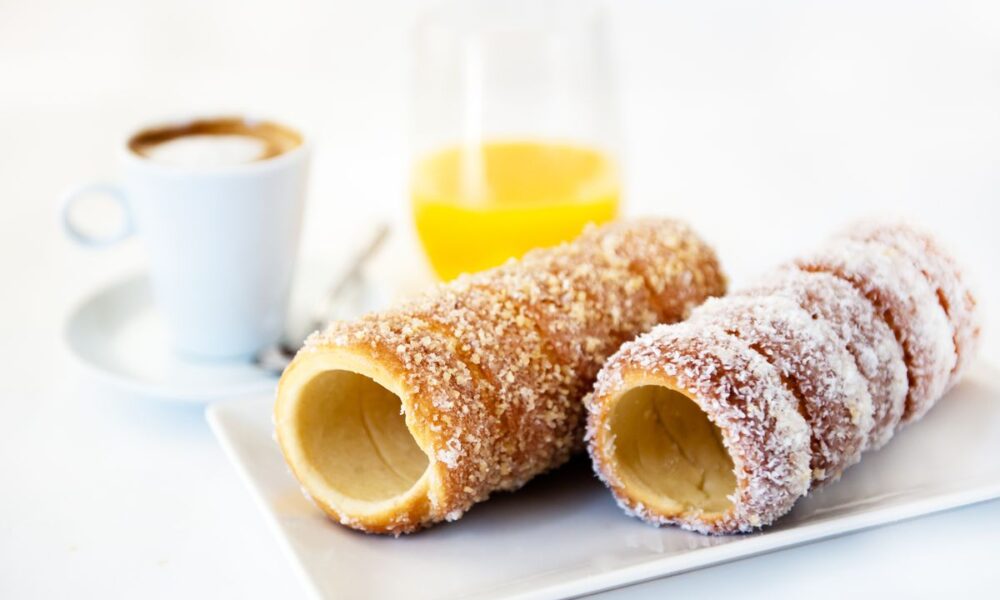Recipes
Do you know kurtoskalacs, the typical dessert of Budapest?

Kurtos kalacs are also called sweet chimneys due to their particular shape. Let's find out everything about this Hungarian dessert.
The term kurtos literally means fireplace and alludes to the particular shape of this Hungarian cannoli prepared with a sort of puff pastry and then cooked while rotating on the embers. As regards the word kalacs , the reference goes to Romania since this dessert actually originated in Transylvania .
Typical street food , it is sold at a cost ranging from 2 to 6 euros depending on the size and the ingredients added after cooking such as cinnamon, poppy seeds, vanilla, almonds or chocolate. The basic recipe for the Hungarian dessert is therefore the same and, thanks to our advice, you can prepare this typical product at home without the need for special tools. Ready to get cooking?
How to prepare the recipe for kurtos kalacs or kurtoskalacs
- Dissolve the yeast in about half the milk and let it rest for 10 minutes .
- In a bowl pour the flour , 50 g of sugar , whole egg and egg yolks beaten with a fork and finally the milk little by little, first the one with the yeast, then the rest.
- Once you have obtained a homogeneous dough (if you use the planetary mixer, wait until it comes together), add the butter in pieces at room temperature and a pinch of salt.
- Transfer everything into a bowl and let rise until doubled.
- Roll out the dough with a rolling pin until it is half a centimeter thick .
- Get the appropriate molds (below we give you some alternatives) and butter them.
- Then cut a 1.5 cm wide strip and roll it around the mold, overlapping it slightly and fixing the final and initial part under the first round so that it does not open during cooking.
- Then brush them with butter and dip them in sugar.
- Place them standing up in the oven and cook at 180°C for 15 minutes , turning every 3 minutes. Remove from the oven, brush again with butter and pass them in sugar flavored with cinnamon or in other ingredients such as coconut flakes, melted chocolate or chopped almonds. Serve them piping hot.
Here are some alternatives to the kurtos mold. If you are unable to obtain the appropriate molds, use empty 500 ml cans, covering them first with foil and then with baking paper. Always brush with butter before rolling the dough to ensure that once cooked it will come off easily.
Alternatively you can use cannoli molds . In this case they will not stand up inside the oven and will be smaller than the originals but the flavor will still be excellent. If you have an oven or an air fryer, you can proceed as seen in this video .
If you liked this recipe, how about trying another typical Hungarian dessert, the palacinka ?
Conservation
The sweet chimneys can be kept for a couple of days wrapped in foil.
Origin and history of kurtos
In 2015 , after a bitter dispute between Hungary and Romania, kurtos were included among the Hungarium , the Hungarian specialties that best represent the country's traditions. But the history of this dessert is much older. The first trace dates back to 400 BC in Greece when a similar dessert was made on the occasion of the festivals dedicated to Dionysus.
To find the first written testimony, however, we had to wait until 1582 . Marx Rumpolt in his book Ein new kochbuk (A new cookbook) translated from German into Hungarian by the wife of the Duke of Transylvania, writes about this dessert but for it to arrive in Hungary and be enriched with modern "toppings" it is necessary to wait another 200 years : we are now in 1789 .
An interesting story regarding the dessert is contained in Balazs Orban's book, the Description of the land of the Secleri , published in 1868. In fact, it seems that this population settled in Transylvania, in the valleys of the Eastern Carpathians, under attack by the Tartars , was forced to take refuge inside the caves. To deceive the invaders, they built a chimney pretending to have enough supplies to resist the siege although this was not the case. The Tatars retreated, leaving the population free.
It's difficult to say how much truth there is in this story. The fact is that today kurtos kalacs is a typical Hungarian dessert. Consumed mainly during the winter and prepared both by pastry shops and small roadside kiosks. Tradition dictates that it is cooked on the embers and enjoyed while walking, unrolling the dough little by little. It is also present in other countries although with different names: in Germany Baumkuchen , in Austria Prügeltorte or Prugelkrapfen , for the Swedes it is Spettekaka .
Riproduzione riservata © - WT